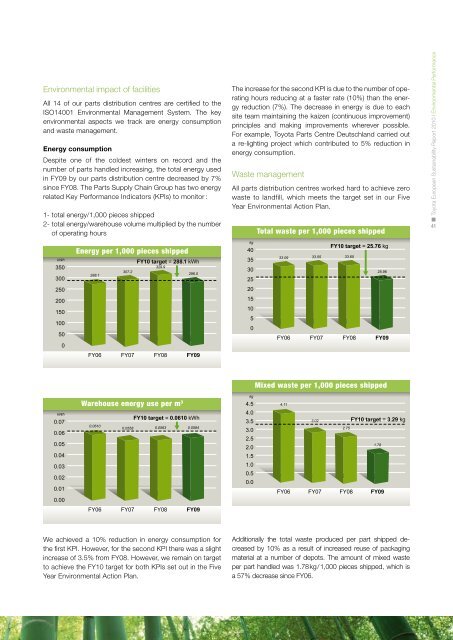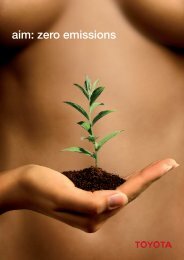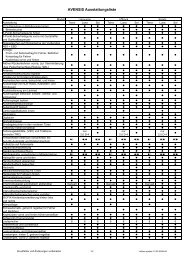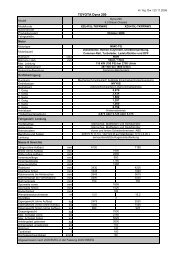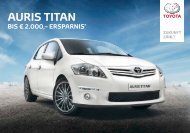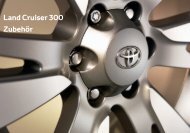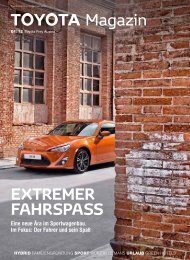Download full report - Toyota Motor Europe
Download full report - Toyota Motor Europe
Download full report - Toyota Motor Europe
You also want an ePaper? Increase the reach of your titles
YUMPU automatically turns print PDFs into web optimized ePapers that Google loves.
Environmental impact of facilities<br />
All 14 of our parts distribution centres are certified to the<br />
ISO14001 Environmental Management System. The key<br />
environmental aspects we track are energy consumption<br />
and waste management.<br />
Energy consumption<br />
Despite one of the coldest winters on record and the<br />
number of parts handled increasing, the total energy used<br />
in FY09 by our parts distribution centre decreased by 7%<br />
since FY08. The Parts Supply Chain Group has two energy<br />
related Key Performance Indicators (KPIs) to monitor :<br />
1- total energy/1,000 pieces shipped<br />
2- total energy/warehouse volume multiplied by the number<br />
of operating hours<br />
kWh<br />
350<br />
300<br />
250<br />
200<br />
150<br />
100<br />
50<br />
0<br />
kWh<br />
0.07<br />
0.06<br />
0.05<br />
0.04<br />
0.03<br />
0.02<br />
0.01<br />
0.00<br />
Energy per 1,000 pieces shipped<br />
288.1<br />
307.2<br />
FY10 target = 288.1 kWh<br />
329.9<br />
296.0<br />
FY06 FY07 FY08 FY09<br />
Warehouse energy use per m 3<br />
0.0610<br />
FY10 target = 0.0610 kWh<br />
0.0558 0.0563 0.0584<br />
FY06 FY07 FY08 FY09<br />
We achieved a 10% reduction in energy consumption for<br />
the first KPI. However, for the second KPI there was a slight<br />
increase of 3.5% from FY08. However, we remain on target<br />
to achieve the FY10 target for both KPIs set out in the Five<br />
Year Environmental Action Plan.<br />
The increase for the second KPI is due to the number of operating<br />
hours reducing at a faster rate (10%) than the energy<br />
reduction (7%). The decrease in energy is due to each<br />
site team maintaining the kaizen (continuous improvement)<br />
principles and making improvements wherever possible.<br />
For example, <strong>Toyota</strong> Parts Centre Deutschland carried out<br />
a re-lighting project which contributed to 5% reduction in<br />
energy consumption.<br />
Waste management<br />
All parts distribution centres worked hard to achieve zero<br />
waste to landfill, which meets the target set in our Five<br />
Year Environmental Action Plan.<br />
kg<br />
40<br />
35<br />
30<br />
25<br />
20<br />
15<br />
10<br />
5<br />
0<br />
kg<br />
4.5<br />
4.0<br />
3.5<br />
3.0<br />
2.5<br />
2.0<br />
1.5<br />
1.0<br />
0.5<br />
0.0<br />
Total waste per 1,000 pieces shipped<br />
33.09 33.55 33.65<br />
FY10 target = 25.76 kg<br />
25.96<br />
FY06 FY07 FY08 FY09<br />
Mixed waste per 1,000 pieces shipped<br />
4.11<br />
3.02<br />
FY06 FY07 FY08 FY09<br />
Additionally the total waste produced per part shipped decreased<br />
by 10% as a result of increased reuse of packaging<br />
material at a number of depots. The amount of mixed waste<br />
per part handled was 1.78 kg / 1,000 pieces shipped, which is<br />
a 57% decrease since FY06.<br />
2.75<br />
FY10 target = 3.29 kg<br />
1.78<br />
<strong>Toyota</strong> <strong>Europe</strong>an Sustainability Report 2010 I Environmental Performance<br />
41


